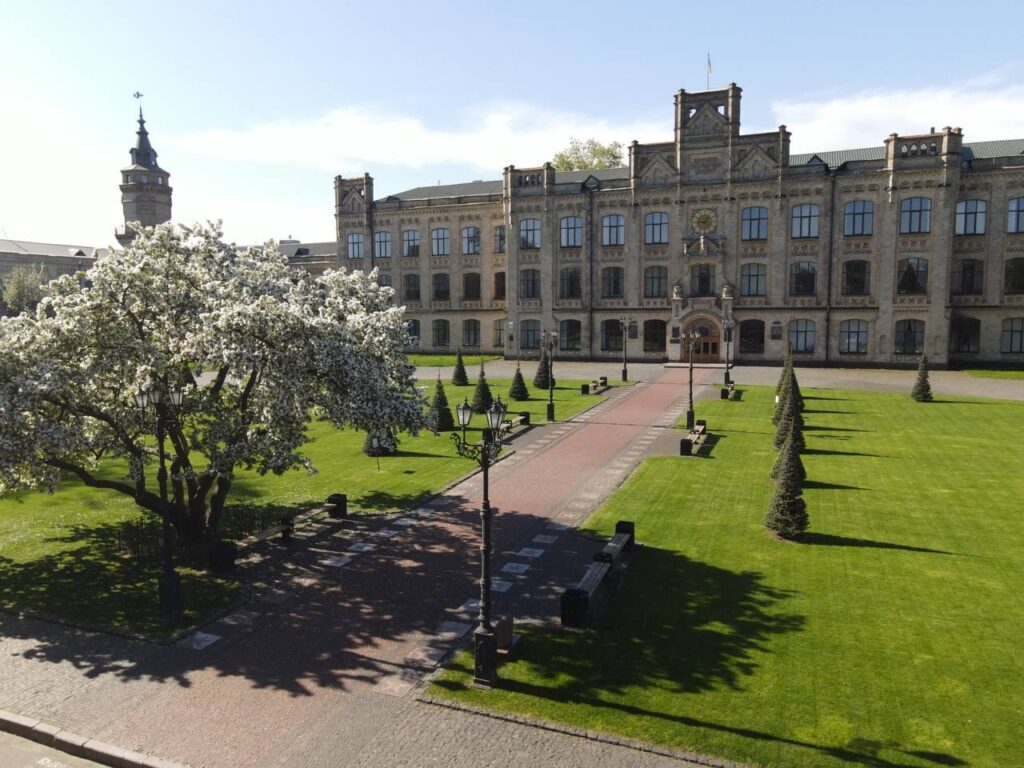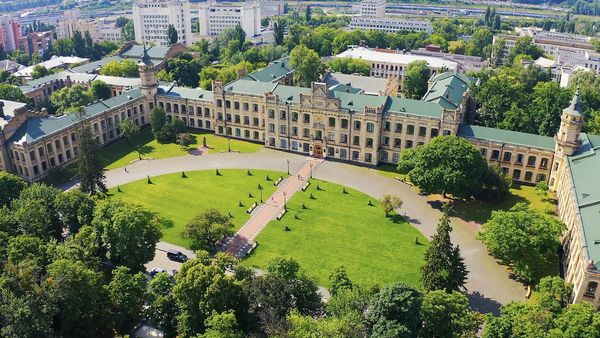On August 31, Igor Sikorsky Kyiv Polytechnic Institute celebrates its 125th anniversary.
One hundred and twenty-five years is a short time in historical terms, but for the Kyiv Polytechnic it is the age of formation and acquisition of its own identity in the global community of universities and in Ukrainian society.
During these 125 years, the Kyiv Polytechnic Institute passed through three socio-political systems and four stages of its evolution.
The first stage fell on the end of the 19th and the beginning of the 20th century. This is the time of formation of the Kyiv Polytechnic Institute as one of the leading higher technical educational institutions in the former Russian Empire.
Founded to meet the needs of the metallurgical, machine-building, sugar-processing industry, railway transport and agriculture, KPI immediately came under the care of prominent scientists and public officials of that time, including Viktor Kyrpychov, Dmytro Mendeleev, Mykola Zhukovsky, Klement Tymiryazev, Eugene O. Paton and others. Laying the KPI foundations, they combined the best achievements of European polytechnic schools: École Polytechnique in Paris, Aachen, Vienna, and Magdeburg Technical Universities.
Viktor Kyrpychov, the first KPI rector, said in his inauguration speech on August 31, 1898: “Kyiv Polytechnic Institute is designed to train engineers, that is, people of genius who are able to invent and arrange new things”.
Thanks to the innovative model of engineering education, there was a combination of in-depth natural and scientific training in general engineering disciplines, the use of laboratory and research equipment and the acquisition of professional skills in KPI foundry and mechanical workshops and at industrial enterprises.
Dmytro I. Mendeleev, head of the State Examination Commission in 1903, assessed the quality of engineer training in KPI as follows: “Having 35 years of experience in the field of graduation in higher educational institutions, I have the courage to assert that I have not seen such a totality of special works in other universities and technological institutes known to me, compared with the Kyiv Polytechnic first graduates”.

In the first years of the KPI activity, professors Yermakov and Bukreev founded the “Mathematics and Statistics” scientific and pedagogical school, professors Kyrpychov, Zvorykin, Tymoshenko became the founders of the “Applied Mechanics” school, the “Solid State Physics” scientific school was founded by professors De-Metz, Goldman, Lynnyk; professors Dementiev, Konovalov, and Yavorsky became the founders of the “Chemical Technologies and Engineering” scientific school, the outstanding biologist Klement Tymiryazev founded the scientific school in the field of agricultural sciences.
At the rector Kyrpychov’s personal invitation, Mykola Pymonenko, member of many European art academies, conducted compulsory drawing classes. Mykola Bilyashevsky, the famous archaeologist and founder of the museum studies in Ukraine, formed and took charge of the KPI technical library. Ivan Le, a student of the Faculty of Road Construction Engineers and a future prominent Ukrainian writer edited the university newspaper “Kyiv Polytechnic”.
In 1905, KPI professors Delaunier, Bobrov, brothers Ivan and Andriy Kasyanenko formed the Aviation Section at the Mechanical Department. By the beginning of the First World War, its members had built more than 40 different types of airplanes, including the world’s first helicopter by student Igor Sikorsky. In fact, this center of aviation has become a powerful research and training center of the aviation profile in Eastern Europe. Most of the world-class aircraft designers of that time were its members.
The famous materials scientist and metallurgist Ivan Bardin, the builder of the first hydroelectric power plants Oleksandr Vinter and many other representatives of the first galaxy of “golden names” of the Kyiv Polytechnic became honored graduates of KPI engineering schools.
The KPI first rector Viktor L. Kyrpychov said about them in 1913: “A special happiness for the institute, a special luck that determined its rapid development, was the opportunity to attract outstanding scientists, professors of various specialties, who became a happy wave of people who gave institution with all their strength and sowed the seed of science, which gave lush shoots and rich harvest”.
The second stage of KPI development fell on the Soviet era. This stage was associated with the unprecedented growth of the institute’s scale, the emergence of thirteen other educational institutions, nine institutes of the National Academy of Sciences, and two large industrial enterprises, on its basis.
Foundation and evolvement of the Ukrainian, and actual National Academy of Sciences of Ukraine became a considerable contribution of Kyiv polytechnics to national and world science. In 1918, in then independent Ukraine, the Academy of Sciences was established on the basis of the leading scientific schools of St. Volodymyr Kyiv University and KPI, by the Decree of Hetman Skoropadsky. Stepan P. Tymoshenko, head of the Department of Resistance of Materials of KPI, and Eugene O. Paton, dean of the Engineering Department, probably the most authoritative mechanicians of the last century, were among the organizers of the Academy.
A large galaxy of KPI professors and graduates later became famous leaders of the Academy. Among them: Mykhaylo Kravchuk, a world-renowned mathematician, Volodymyr Plotnikov, an outstanding electrochemist, Georgiy Pysarenko, a researcher in the theory of vibrations and strength of materials, Mykola Kilchevsky, an outstanding scientist in the field of theoretical mechanics, Ivan Chyzhenko, a researcher in the field of theoretical foundations of electrical engineering, Viktor Trefilov, an outstanding materials scientist. An unparalleled labor feat of Borys E. Paton, a 1941 KPI graduate, was his activity at the head of the National Academy of Sciences of Ukraine.
Now, members of the National Academy of Sciences of Ukraine – Mykhaylo Ilchenko, Yuriy Yakymenko, Petro Loboda, Serhiy Sydorenko, Mykola Bobyr, Nataliia Pankratova, Oleksiy Novikov augment the glorious academic traditions of their predecessors.
Industrialization caused creation of new scientific and pedagogical schools at KPI. Professors Delaunay, Lysin, and Plygunov founded the “Technology and Equipment of Industrial Machine Building” scientific school, professors Krukovsky, Artemiev, Gorodetsky became the founders of the “Electroenergetics, Electrical Engineering and Electromechanics” scientific school. The scientific school “Materials Science, Metallurgy, Welding” was founded by professors Eugene Paton, Vasyliev, Dobrokhotov, Vashchenko, Grydniev, the radio engineering scientific school was founded by professors Ogievsky and Tetelbaum, professors Radtsyg, Zvorykin, Stupin, Kondak, Shvets, Tolubinsky, Kichygin were the founders of the thermal energy scientific school.
During that stage, KPI graduates and its scientific units gave the country and the world a number of the most important scientific and technical achievements of the last century.

In 1928, KPI professor Eugene O. Paton was the first in the world to use electric welding technology for bridge construction, which later made it one of the principal technologies of the 20th century. Borys E. Paton continued the father’s work; he developed unique technologies of electric welding in space, under water, and welding of living tissues.
A KPI graduate in 1925, the outstanding Soviet aircraft designer Kostiantyn Kalinin created a whole generation of aircraft of the pre-war period; his K-7 aircraft, made according to the “flying wing” aerodynamic scheme, was the biggest in the world. Later, Kalinin’s “flying wing” scheme became the basis of supersonic aviation.
Students of the 1930s, Sergiy Koroliov and Volodymyr Chelomey, were the first in the world to conquer space: Koroliov was the chief designer of the USSR space program, and Chelomey was a R&D engineer of rocket engines for the Voskhod and Vostok spaceships and a unique Proton rocket.
The developer of the world’s first anti-missile defense systems was a twice awarded the Hero of Socialist Labor, a KPI graduate in 1931, Lev Lyulyev. Another graduate of the same year, Arkhyp Lyulka, started a new generation of turbojet engines, which is still the basis of modern aviation.
During the Second World War, KPI laid on the altar of Victory its best scientific and technical achievements, the best personnel potential, the lives of many students and professors, whose memory is preserved in a form of the eternal glory pedestal in the university park.
The post-war KPI is indebted to the rector Oleksandr Plygunov, who headed the institute for 25 years, for the rapid reconstruction and return to the atmosphere of high academic culture and pedagogical excellence. At that time, scientific schools were established in the fields of electronics and acoustics, automation and instrument engineering, cybernetics, computing and informatics. Every year, hundreds of foreign citizens returned to their countries with KPI diplomas. Among them, there were two future ministers of the Popular Republic of China: Liu Jiangfeng (civil aviation) and Hu Guangyuan (mechanical engineering); Poland’s Minister of Education Wojciech Swientoslawski, R&D engineer and owner of the wind energy industry in the USA Mykhaylo Polskykh.
A brilliant constellation of artists, sportsmen, and public officials emerged from the ranks of KPI. Among them: composer Mykola Dremlyuga, artistic director of the National Opera Anatoliy Mokrenko, Olympic champions Larysa Latynina and Yuriy Titov, prominent football player and coach Valeriy Lobanovsky, head of the government of Ukraine during the USSR and at the beginning of independent Ukraine Vitaliy Masol and other outstanding personalities.
The third stage coincided with the beginning of the Ukrainian state formation. The university played an important role in gaining and establishing the independence of Ukraine. On September 8–10, 1989, the 1st (founding) congress of the People’s Movement of Ukraine was held in the KPI. Students and employees of the university were active participants in the Orange Revolution of 2004 and the Revolution of Dignity in 2013-2014.
Petro Talanchuk, the first elected university rector in the USSR and the first minister of education of independent Ukraine initiated the democratization of university life. Responding to the challenge of the times, KPI transformed from the model of a polytechnic institute, which was rigidly embedded in the centralized economy of the former USSR, to a model of a European-style technical university with universal training in accordance with the new needs of the society.
The universalization of education and scientific research required a combination of fundamental-natural, engineering-technical, economic and humanitarian components for specialist training. 12 new faculties and educational and scientific institutes, more than 50 departments were founded, more than 100 new specialties and specializations started. In those years, the number of KPI students reached 42,000, and together with professors, scientists, and employees, the Kyiv Polytechnic community united a team of 50,000 persons.
The new methodology of interdisciplinary studies of complex natural and social phenomena necessitated the creation of a scientific school for system analysis, together with the Institute of Cybernetics of the National Academy of Sciences of Ukraine. Academician Mykhalevych and a whole cohort of famous scientists became its founders.
In its structure, the KPI created institutions of a national scale. This is the first State Polytechnic Museum in Ukraine; the Kyiv Polytechnic Science Park and the Sikorsky Challenge innovation ecosystem spread over 14 regions of Ukraine; “Polytechnic” publishing and printing complex; “KPI-Telecom” telecommunication service operator; URAN educational and scientific information network, which is a national representative in the European GEANT network and supports leading universities and scientific centers of the country; there are 35 international centers and organizations that carry out the practical integration of KPI into the global and European scientific and educational space.
Hence, KPI became a much larger entity than a traditional higher educational institution. It was included in 4% of the most authoritative universities in the world according to a number of international ratings, became a major educational, scientific and innovative, methodological center of the state, an island of breakthrough in a number of high-tech spheres.
Since 2010-2012, KPI entered the fourth stage of its evolution, having adopted a new university development strategy in 2012. Based on interdisciplinary, innovative programs, on the activities of 35 international scientific and educational centers and the Sikorsky Challenge innovation ecosystem, KPI forms a strategy for transition of Ukraine from a low-tech and commodity-based economy to a high-tech and competitive economy.
At the beginning of this stage, KPI became a platform for the development of new legislation in the field of higher education. It first laid down the principles of systemic interaction of higher education, science, business and government, the principles of university autonomy, the European knowledge assessment system, and other modern approaches.
The space program of the university became one of its important achievements. Designing and launching research spacecraft into space, KPI became the undisputed leader of this branch in Ukraine.
The foundations were laid for the further development of KPI as a research university based on the Sikorsky Challenge innovation ecosystem.
Finally, the university team ensouled the walls of the 125-year-old KPI. Monuments to outstanding polytechnics, Art Galleries, the State Polytechnic Museum, the hall of the Academic Council, university squares and parks, Foucault’s pendulum, chimes on the main building, and other signs of respect for rooted academic traditions create a sense of contemporaries’ belonging to the glorious history and great deeds of their predecessors.
At the same time, this stage brought unprecedented challenges and trials. The war in the East, the occupation of Crimea, Russia’s full-scale aggression against Ukraine. Professors, scientists, students of the university made a stand for the Motherland through a time of severe troubles. From 2014 to 2016, KPI lost 14 of its heroes, 4 of them were awarded the title “Hero of Ukraine” posthumously. From February 24, 2022 to the present, 50 Kyiv Polytechnic students gave their lives for the freedom and independence of Ukraine.
The new realities made it necessary to add to the university’s development strategy an increase in the state’s defense capability and the initiation of the basic principles of national resistance.
The university significantly expanded the training of personnel for the defense establishments and the Armed Forces of Ukraine. Thus, 169 holders of a master’s degree were trained for the defense industry under the “Management in the field of the defense-industrial complex” program. 109 members of the Armed Forces of Ukraine were retrained according to the “School of Professional Development of Design Engineers”, “Implementation of Standardization and Quality Management System at Defense Industry Enterprises” and “Professional Improvement of Engineers of Unmanned Systems and Complexes” programs. Today, the university makes every effort to win, and develops a platform for the post-war innovative transformation of the country, which will probably still be in an unfriendly neighborhood. Some of the basic principles of this platform are as follows:
1. Based on the many years of experience of the universities of Israel and Switzerland, KPI introduces a 5-credit course of national resistance in the curricula with the basics of pre-medical, fire and psychological training, crisis management, response to emergencies, humanitarian aspects of military conflicts and the aftereffects of war.
2. KPI strengthens the component of fundamental and advanced engineering knowledge, ensuring the development of students’ critical thinking competencies, the ability to analyze Big Data, adapt to rapid changes and engage in lifelong self-learning.
3. KPI improves the model of the research university. Currently, the innovative Sikorsky Challenge ecosystem is based on 67 KPI scientific schools, more than 100 high-tech companies, investment and venture funds, a group of high-tech enterprises of Ukraine, 12 branches of the Sikorsky Challenge startup school in 25 universities of Ukraine.
4. KPI provides the development of a lifelong learning program based on reskilling and upskilling for those already in work to help them adapt to rapid changes and develop their careers. This especially applies to the sphere of defense and security of Ukraine.
5. KPI consistently implements the “digital university” concept, using artificial intelligence technologies, virtual and augmented reality, cloud services and other tools.
6. Education of students based on sustainable development became an imperative requirement for KPI. In this context, the university is constantly transforming to a model of high-energy efficiency, based on implementation of new energy-saving, environmentally friendly technologies, the safety of members of the university community, social orientation and economic sustainability.
KPI lives for 125 years, it is a contemporary of three centuries — XIX, XX and XXI, and in each of them it was and is an advanced higher technical educational institution. Today, Kyiv polytechnics bear responsibility for the high authority acquired by their predecessors, and the obligation to increase this authority at the new stage of the social development.
Michael Zgurovsky, Rector of NTUU “Igor Sikorsky Kyiv Polytechnic Institute”, Academician of the National Academy of Sciences of Ukraine
